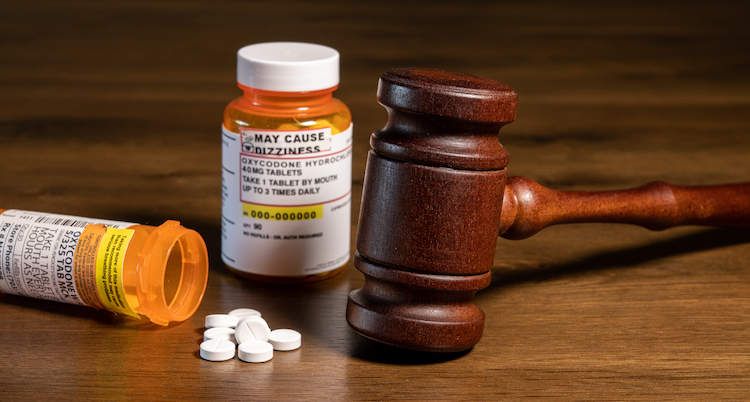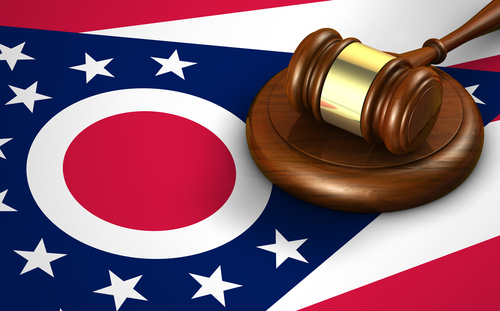$465M verdict against maker of opioids is tossed; top state court finds no public nuisance

Image from Shutterstock.
The Oklahoma Supreme Court on Tuesday overturned a $465 million verdict against Johnson & Johnson, accused of creating a public nuisance through a misleading marketing campaign that promoted opioid use.
In a 5-1 decision, the Oklahoma Supreme Court said Johnson & Johnson’s opioid marketing did not create a public nuisance because it concerned the sale of a lawful product.
“We hold that the district court’s expansion of public nuisance law went too far,” the state supreme court said.
Judge Thad Balkman of Cleveland County, Oklahoma, had found liability in August 2019 after a bench trial. He cited the state’s unusual public nuisance law, which does not require interference with property.
Balkman had ruled in a case brought by the state attorney general. Two other defendants in the case—Purdue Pharma and Teva Pharmaceuticals—had settled before trial.
The state supreme court acknowledged that the state’s public nuisance law covers interference with the rights of the community at large. But “the state’s allegations in this case do not fit within Oklahoma nuisance statutes as construed by this court,” the court said.
The state supreme court said it has has applied the nuisance statutes to conduct that endangers health and safety.
“But that conduct has been criminal or property-based conflict. Applying the nuisance statutes to lawful products as the state requests would create unlimited and unprincipled liability for product manufacturers; this is why our court has never applied public nuisance law to the manufacturing, marketing and selling of lawful products,” the state supreme court said.
The state had characterized the public nuisance as an interference with the public right of health. But public nuisance cases involving public health have involved diseased animals, polluted drinking water or the discharge of sewage on a property, the court said.
Such property-related conditions have no benefit, the court said. But prescription opioids have a beneficial use in treating pain.
The state had contended that Johnson & Johnson was or should have been aware of dangers associated with opioid abuse and addiction and should have warned the public.
But a failure to warn is an allegation in products liability cases, a tort that is distinct from public nuisance, the court said. The court cited the Restatement (Third) of Torts, which said most courts have rejected nuisance liability theories in cases involving products that caused harm.
Another reason to reject liability, the court said, is that opioid manufacturers have no control over the misuse of their products after the sale. The court drew a parallel to a case rejecting the contention that gun-makers have a duty to lessen the risk of illegal trafficking.
The court noted that Johnson & Johnson had sold only 3% of prescription opioids in the state and no longer promotes prescription opioids. The verdict against Johnson & Johnson was not based on the percentage of opioids it sold; rather, the judge held the company responsible to abate harms caused by all opioids. But Johnson & Johnson does not control how other companies’ opioids were used, the Oklahoma Supreme Court said.
The court also said that nuisance cases sidestep statutes of limitations. Liability in this case could mean that Johnson & Johnson is held “continuously liable for its products,” the court said. “Oklahoma law has rejected such endless liability in all other traditional tort law theories. We again reject perpetual liability here.”
The ruling is the second time this month that a court found fault with a public nuisance suit against makers of opioids. A judge in California said in a tentative ruling that the government plaintiffs had failed to show how many medically unnecessary prescriptions were written as a result of alleged misleading marketing by makers of opioids.
Even if he could infer that misleading marketing caused an increase in inappropriate prescriptions, said Judge Peter J. Wilson of Orange County, California, there is no evidence showing whether and how much the volume of such prescriptions contributed to a public nuisance.
The Washington Post, Law.com and the New York Times are among the publications with coverage of the Oklahoma decision. How Appealing links to additional coverage.
The New York Times and the Washington Post spoke with Elizabeth Burch, a professor at the University of Georgia School of Law, who has followed opioid litigation.
“Are these two outlier opinions, or are they trendsetters? I think it’s too early to be able to tell right now,” she told the Washington Post.
But she said the Oklahoma ruling, which went further than the California decision, could influence plaintiffs’ response to a proposed $5 billion national settlement offer made by Johnson & Johnson.
“If I was a plaintiff that was on the fence about whether to enter the J&J settlement, this ruling might push me closer to settling, if I was risk averse,” Burch told the New York Times.



